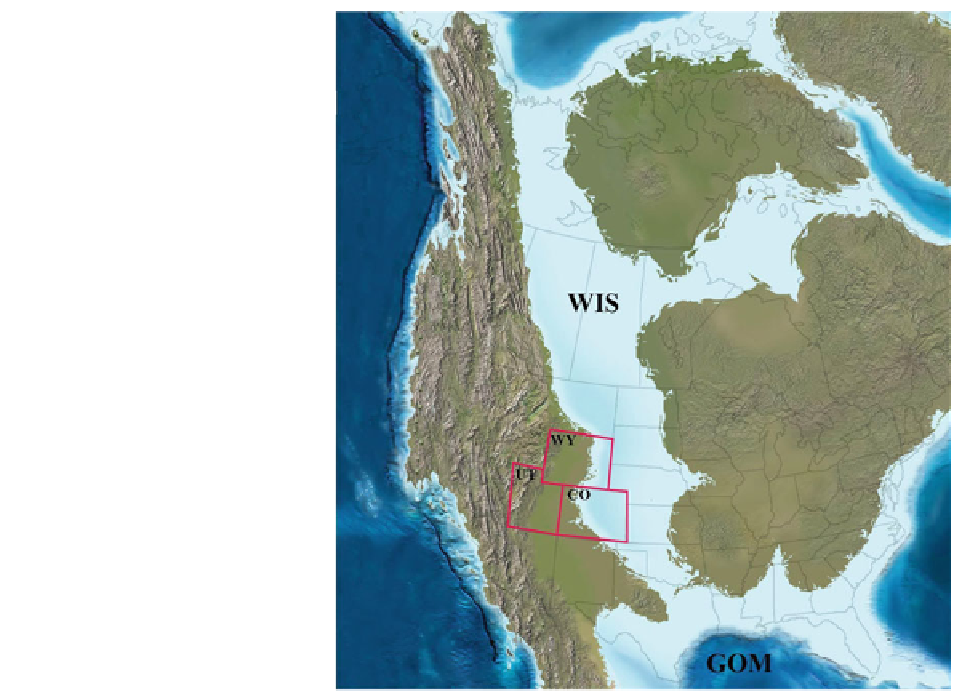Geology Reference
In-Depth Information
Fig. 17.1
The Western
Interior Seaway at 75 Ma as
portrayed by Blakey, NAU
Geology. The study areas of
Utah, Colorado and Wyoming
are highlighted. The map
here would be typical of the
wide seaway at sea-level
highstand. During the
Campanian there were
repeated, high-frequency
(several 100 ky) changes in
the width (100s of km) of the
basin, with the western
margin lowstand shorelines
positioned as far east as the
eastern borders of Wyoming
and Colorado. Note the
narrow seaway opening to the
south, imposing general
microtidal conditions in the
basin
have demonstrated ample tidal infl uence or even tidal
dominance along some Campanian coastlines of this
seaway. As early as mid-1960s tidal signals were well
documented within Campanian strata of S Wyoming
and N Colorado (Weimer
1966
; Masters
1966
) . By late
1970s there was a more general awareness of the
importance of tides in shelf seas (Klein and Ryer
1978
). By late 1980s-early 1990s tidal estuarine
deposits (e.g., Rahmani
1988
), and strong tidal infl u-
ence in transgressive strata (e.g., Cross
1988
) were
well known. In a key paper Devine (
1991
) argued for a
reinterpretation of the uppermost parts (commonly
interpreted as upper shoreface or distributary channel
deposits) of some Campanian regressive units. He
argued that they are commonly transgressive estuarine
deposits, because of the common occurrence of capping
units of muddy lagoonal deposits overlain by thick (up
to 15 m) channelized deposits showing evidence of
transport by fl ood-oriented tidal currents. Through the
1990s, tidal deposits in the region of the Book Cliffs of
Utah had been well documented (Van Wagoner
1991
;
Kirschbaum and Hettinger
1998
). At this time there
was some reluctance to accept in principle that regres-
sive deltas could be tide-dominated (e.g., Walker
1992
;
Bhattacharya and Walker
1992
) though later such
designation became accepted (Bhattacharya and Willis
2001
). The study region had become important for
more intensive research on tidal deposits at this time,
notably on three themes: (1) the recognition of signifi -
cant tidal infl uence on units such as Shannon Sandstone
(Suter and Clifton
1999
, Bergman and Sneddon
1999
)
or Sego Sandstone (Van Wagoner
1991
) and the ensu-
ing debate about whether tidal units such as Sego
Sandstone occupied mainly estuarine incised valleys
(e.g., Van Wagoner
1991
; Wood
2004
) , or represented
deltas with large-scale tidal scouring, not necessarily
related to base-level changes (Willis and Gabel
2001,
2003
), (2) the importance of tidal deposits (within
short-lived marine incursions) for correlation of marine
into coeval nonmarine strata (e.g., the classic study of
Shanley et al.
1992
, as well as that of McLaurin and
Steel
2000
; but see also Yoshida et al.
2001
) , and (3)
the proposal that the tide-dominated deltas of the
lower Haystack Mountains Fm. of S. Wyoming were

